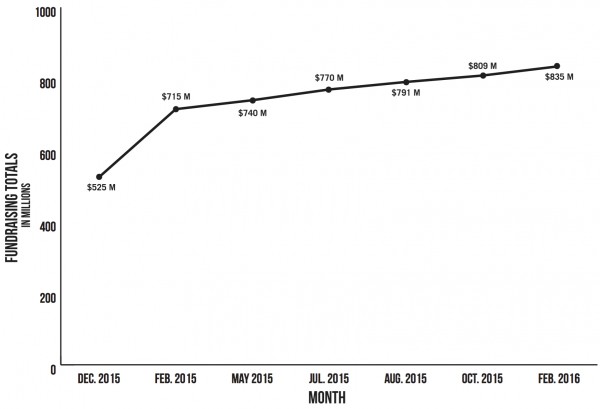Updated: Feb. 24, 2016 at 1:41 p.m.
The University has reached nearly 85 percent of its $1 billion fundraising goal.
Aristide Collins, the vice president for development and alumni relations, told Faculty Senate this month that officials have raised $835 million for the fundraising campaign. But that amount is just a 3 percent increase from the fundraising total announced in October – the slowest fundraising rate since the campaign’s public launch nearly two years ago.
The campaign has brought in an average of $6.5 million per month since October. During this period of time last year, funds raised averaged $23 million per month. Experts said it is normal to see the momentum decrease over time because fundraisers have already tapped into larger donors and are focusing more on donations from populations like students and alumni.
Collins said in an email that he hopes some of the larger donations made this year, like the $2.5 million gift that started the Loeb Institute for Religious Freedom, will inspire others to make sizable contributions.
GW received its largest-ever gift before the campaign went public in 2014: $80 million that renamed the Milken Institute School for Public Health.
Although administrators previously discussed the possibility of extending the campaign beyond its June 2018 deadline, Collins said that the goal of the campaign remains to raise the $1 billion by that date.
“Every gift, no matter what size, makes a difference in reaching that goal,” Collins said.
University President Steven Knapp confirmed in an interview that he intends to maintain the June 2018 goal, but that fundraising efforts will not end then. He said that while the $835 million total is a University-wide figure, individual schools are progressing toward their respective goals at different rates and will continue to fundraise to meet them.
Knapp said his office is already looking ahead to a future campaign.
“You think of going up to a plateau, and then you’re at that plateau and then you go up to the next plateau,” Knapp said. “The point of the campaign is not just to raise the money in the campaign, but to get the whole University geared to raising money annually at a higher rate.”
Michael Knetter, the president and CEO of the University of Wisconsin foundation, said he expects the University of Wisconsin’s $3.2 billion campaign, which launched publicly in October, to experience a similar slowdown as the campaign advances.
Knetter said the cycle is not uncommon in large campaigns, and said some factors that influence donations are out of a university’s control: donor enthusiasm, performance of global markets and how people feel about their investments.
“Just because things have slowed down doesn’t mean the development team has done anything different or wrong,” Knetter said. “It’s just the nature of the beast.”
Erika Bernal, the director of development and alumni relations at Marshall B. Ketchum University, said the leveling off could also be a sign of donor fatigue – as large campaigns continue, it can be a challenge for officials to keep donors excited over the course of several years.
She also said it could be a sign GW hasn’t done enough to expand its donor pool throughout the campaign. Officials had hoped to expand their donor base during the campaign by tapping into the Corcoran College of Art + Design’s donor base. GW took over the arts school in 2014. About 56,800 people have contributed to the campaign so far.
“You end up capping out at a certain point because you’ve touched all those donors, and so without finding new donors or new grants, or tapping into those larger donors who have made your closing gift promises, you would see kind of a leveling off,” Bernal said.
But Bernal said the slowdown could be remedied by donors who make “closing gifts” – large gifts near the end of a campaign.
“You could take some of those closing donors and help promote the final needs with other alumni or do a match grant,” Bernal said. “They can be a little bit more creative knowing they have those donors in the works.”







